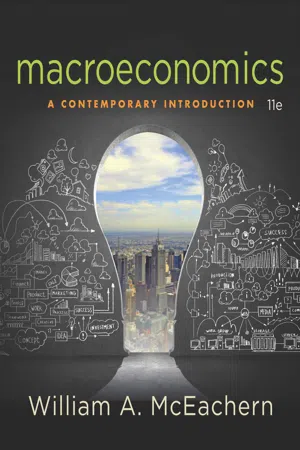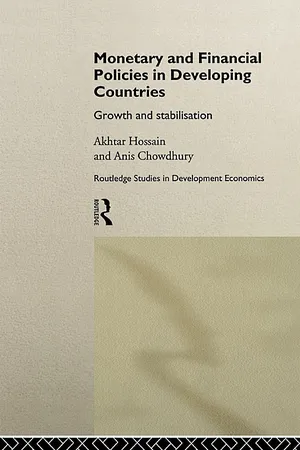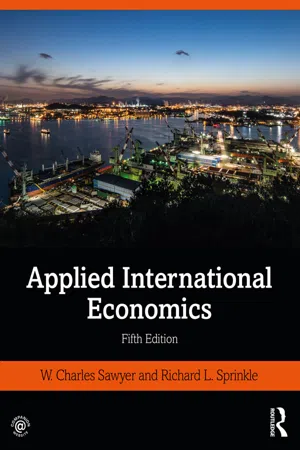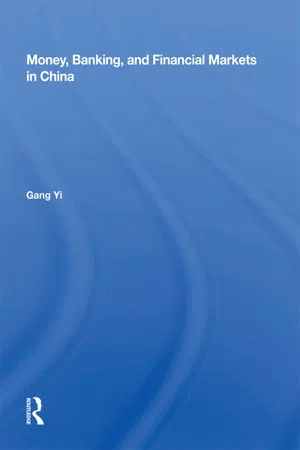Economics
Increase in Money Supply
Increase in money supply refers to the overall growth in the amount of money in circulation within an economy. This can occur through various means, such as central bank interventions, government fiscal policies, or changes in banking regulations. An increase in money supply can lead to inflation if the growth outpaces the production of goods and services in the economy.
Written by Perlego with AI-assistance
Related key terms
1 of 5
8 Key excerpts on "Increase in Money Supply"
- eBook - PDF
Economics
Theory and Practice
- Patrick J. Welch, Gerry F. Welch(Authors)
- 2016(Publication Date)
- Wiley(Publisher)
Under these circumstances, Q in the equation of exchange could go up very little, if at all. At full employment, an increase in the money supply would lead primarily to an increase in the price level, the P term, or to inflation. A decrease in M decreases total spending, the left‐hand side of the equation of exchange. This, in turn, causes a decrease in the dollar value of output, the right‐hand side of the equation. A decrease in the money supply typically results in a decrease in Q, or production and employment. P , or the overall price level, usually does not fall with a decrease in total spending. Businesses generally respond to decreases in spend- ing by cutting production rather than by lowering prices. However, if the economy were operating at or near full employment and experiencing inflation, a decrease in the money supply would dampen some of the upward pressure on prices, causing prices to rise less rapidly. In summary, the relationship between total spending and the economy’s produc- tion, employment, and price levels is affected by changes in the economy’s supply of money. Increasing the money supply facilitates spending and contributes to an expan- sion of economic activity. Whether this leads to increased production and employment or to inflation depends in large part on how close the economy is to full employment. Decreasing the supply of money inhibits the spending ability of businesses and house- holds and in turn slows the level of economic activity. MONEY CREATION We know that money is created when financial depository institutions make loans, and money is destroyed when those loans are repaid. Although these loan‐making institu- tions include savings associations and credit unions, it is the commercial banks that are primarily engaged in money creation and destruction. Because of the huge impact that 2 Some economists write the equation of exchange as an identity: MV PQ . - eBook - PDF
Monetary Economics
Policy and its Theoretical Basis
- Keith Bain, Peter Howells(Authors)
- 2017(Publication Date)
- Red Globe Press(Publisher)
If, however, the authorities could not control the monetary base or changes in the monetary base did not have a predictable impact on the money supply, banks might go on meeting the increased demand for credit as people sought to borrow more in order to increase their spending. The stock of bank deposits, and hence of money, would increase (the money supply would be endogenous). In other words, the supply of money might simply increase to meet the increased demand for it and an excess demand for narrow money might never arise. Thus, whether an increase in the demand for narrow money, even at an aggregate level, is of much significance depends on the nature of the money supply process in the economy. Let us for the moment accept the exogenous money version and assume that the monetary authorities seek to reduce inflationary pressure by restricting the rate of growth of the monetary base in the expectation that this will restrict the ability of banks to lend, force up the rate of interest and deter people from bor-rowing. For the monetary authorities to follow such a policy, they would need to believe that the relationship between the supply of money and the level of spend-ing in the economy was close and stable. To put it another way, they would need to believe that the demand for money was stable. This, in turn, would imply a stable technical relationship between the amount of money in the economy at any particular time and the total amount of spending able to be undertaken: the veloc-ity of money would need to be stable. To test for this, we need a clear definition of money and the argument above suggests that this should be a narrow defini-tion. However, if the supply of money is endogenous, the demand for money loses much of its importance and our need for a precise definition of money is also much diminished. - eBook - ePub
Macroeconomics
(With Study Guide CD-ROM)
- Jagdish Handa(Author)
- 2010(Publication Date)
- WSPC(Publisher)
M 0 but not its multiplier α, so that it needs to know the multiplier α reasonably well to be able to control the money supply.Figure 6.1 shows the exogenous money supply curve by the Ms curve. Note that in this case, the horizontal axis represents the nominal money supply. The money supply curve Ms shown is vertical under the assumption that it is determined exogenously and, therefore, is independent of the interest rate. That is, an increase in the nominal interest rate from R0 to R1 leaves the money supply unchanged at M0 . The money supply is also independent of output and the price level in the economy, so that the shifts in these variables will not move the Ms curve. When the money supply does not vary with the interest rate or any other variable, it is referred to as the money stock.If the central bank increases the monetary base and thereby increases the money supply, it would move the money supply curve to the right from M s 0 to M s 1 in Figure 6.1.6.2 The Demand for MoneyAs discussed in Chapter 2 , money consists of items that serve as the medium of payments in the economy. In practice, it is represented by M 1, M 2, or one of the still broader monetary aggregates. The demand for money was also discussed in Chapter 5 . The presentation below is an iteration and elaboration of the analysis of money demand presented in Chapter 5 .Holdings of money vary during each period. For example, the consumer may start a week with, say $100, and spend it during the week, ending the week with zero money holdings. To avoid dealing with such variations, macroeconomics focuses on the average money balances held during the week or period in question. Further, the consumer is taken to be free of money illusion and determines his demand for money in real terms, since the real value of money holdings is the proper indicator of their purchasing power in terms of commodities. Hence, the money demand variable is the real value of average money holdings over the period in question. The real value of these average money holdings is called ‘real balances’. To arrive at real balances m, divide the nominal balances M held by the public by the price level P , so that m = M/ P - eBook - PDF
Macroeconomics
A Contemporary Introduction
- William A. McEachern(Author)
- 2016(Publication Date)
- Cengage Learning EMEA(Publisher)
Cengage Learning reserves the right to remove additional content at any time if subsequent rights restrictions require it. Chapter 15 Monetary Theory and Policy 331 EXHIBIT 2 Effect of an Increase in the Money Supply Because the money supply is determined by the Federal Reserve, it can be represented by a vertical line. At point a, the intersection of the money supply, S m , and the money demand, D m , determines the market inter- est rate, i. Following an increase in the money supply to S9 m , the quantity of money supplied exceeds the quantity demanded at the original interest rate, i. The new equilibrium occurs at point b. Interest rate M M’ 0 Quantity of money D m i i ’ a b S m S ’ m are able to hold more money. But at interest rate i they are unwilling to hold that much. The opportunity cost of doing so is too high. Because people are now holding more of their wealth as money than they would like, they exchange some money for other finan- cial assets, such as bonds. As the demand for bonds increases, bond sellers can pay less interest yet still attract enough buyers. The interest rate falls until the quantity of money demanded just equals the quantity supplied. With the decline in the interest rate to i9 in Exhibit 2, the opportunity cost of holding money falls enough that the public is willing to hold the now-larger stock of money. Equilibrium moves from point a to point b. For a given money demand curve, an increase in the money supply drives down the interest rate, and a decrease in the money supply drives up the interest rate. Now that you have some idea how money demand and money supply determine the market interest rate, you are ready to see how money fits into our model of the economy. Specifically, let’s see how changes in the money supply affect aggregate demand and equilibrium output. C H E C K P O I N T Explain how the demand and supply of money determine the market interest rate. Copyright 2017 Cengage Learning. All Rights Reserved. - eBook - ePub
Monetary and Financial Policies in Developing Countries
Growth and Stabilization
- Anis Chowdhury, Akhtar Hossain(Authors)
- 2003(Publication Date)
- Taylor & Francis(Publisher)
Chapter 5 that money supply affects real output only in the short run so long as there are rigidities in the system. On the other hand, there is overwhelming evidence showing that monetary expansion has been an important influence on inflation. Thus there is a broad consensus that the stability of the price level should be the ultimate goal of monetary policy.A MONEY MULTIPLIER MODEL OF THE MONEY SUPPLY PROCESS
This section specifies a simple model of the money supply process to examine the controllability of monetary aggregates in developing countries.1 The model is based on the fractional reserve system in which commercial banks are required by law to keep a fraction of their deposit liabilities as reserves with the central bank.Monetary aggregates can be defined either narrowly or broadly. The narrow money (M1) comprises currency in circulation (Cp) and demand deposits (Dd)The broadly defined money (M2) iswhere Dt=time or fixed deposits. Assuming that total deposits are divided into demand and time deposits in a fixed ratio (e), thenSubstitution of equation (6.3) in equation (6.2) yieldsWhile the currency held by the non-bank public (Cp) is the central bank’s liability, deposits (Dd and Dt) are the liabilities of commercial banks. Thus M1 and M2 represent the liabilities of the banking system and it is essential to examine the balance sheet of the banking system for an understanding of the process of money creation. The central banks balance sheet is given as - eBook - PDF
India's Economic Prospects - A Macroeconomic And Econometric Analysis
A Macroeconomic and Econometric Analysis
- Thampy Mammen(Author)
- 1999(Publication Date)
- World Scientific(Publisher)
Chick (1983) points out that there is a revolving fund consisting of consumption and investment spending, and profit and wage income which remain within the banking system as its liability that could finance the existing level of spend-ing. Any higher level of spending in investment or any other spending will necessitate a larger revolving fund that would be met by the banks. (The reason there is a revolving fund is that the short term finance provided by the bank to the producer while goods are being produced will be spent on resources such as labor and returned to the banking system as deposits, with the exception of some leakage into cash or other types of financial as-sets (Wray 1990). Since bank money is created in the process of production or speculation, money supply is the result, rather than the cause, of aggre-gate demand (Roger 1989, p. 175). The reason for the stable relationship between income (Y) and money (M), argues Kaldor, is that the causation runs from Y to M and not from M to Y. New money comes into existence in consequence of, or as an aspect of, the extension of bank credit. (Kaldor 1982, p. 22). Expenditures are financed by credit, which raises the level of the money supply. So money supply is demand-determined. But demand may vary with income, and the Central Bank can effectively influence the level of credit through changes in the bank rate. That, however, does not alter the fact that demand determines the money supply (ibid., p. 24). Supply and Demand for Money 157 The central bank cannot control the monetary base except through changing the bank rate at which it creates bank reserves through lend-ing or discounting. But it cannot refuse to lend to the banks without endangering the solvency of the banking system; they must maintain their function as a lender of the last resort, (ibid., p. 25). Moore makes the same argument: The banks first meet the demand for loans and then meet the legal reserve requirement. - eBook - ePub
- W. Charles Sawyer, Richard L. Sprinkle(Authors)
- 2020(Publication Date)
- Routledge(Publisher)
market. When the central bank buys or sells a bond, either the banking system’s reserves change or the amount of currency in circulation changes. If the central bank buys a bond in the open market from a commercial bank, the central bank pays for the bond by increasing that bank’s reserves by the amount of the purchase. If the central bank buys a bond in the open market from the public, the effect on commercial bank reserves is much the same. The individual who sold the bond receives payment by a check drawn on the central bank. When this check is deposited in a commercial bank, the bank’s reserves increase. In either of these two cases, this transaction increases the reserves of the banking system and the monetary base. As a result, the money supply will rise by a multiple of that amount.The reverse would happen when the central bank sells a bond. In this case, the banking system’s reserves fall, the monetary base falls, and the money supply declines. Given an estimate of the value of the money multiplier, a central bank using open market operations can precisely control the monetary base, and control the money supply with some degree of precision. The key institutional characteristic necessary for open market operations is the existence of an active secondary bond market.4 The central bank needs to be able to easily buy and sell bonds in its attempts to control the money supply. If a secondary market for bonds does not exist, control of the money supply becomes much more difficult. Assuming such a market does exist; changing the money supply becomes relatively easy for the central bank. However, like any other asset, the money supply and changes in the money supply are only half the story. To determine the price of money, meaning the interest rate, one must also consider the demand for money.THE DEMAND FOR MONEYHaving described how a country’s money supply is determined, we can now turn our attention to the other side of the money market, the demand for money. In many respects, money is an asset much like any other asset. The main difference is that money is a very good substitute for practically all other goods and services. The decision to hold money balances is a portfolio decision, as firms and individuals have some desired level of money balances that they wish to keep on hand. As such, there are three major reasons for individuals and firms to hold money. - Gang Yi(Author)
- 2019(Publication Date)
- Routledge(Publisher)
Money (Ml}= (Currency in circulation+ Deposits of other domes-tic transactor + Demand deposit in the banking system + Demand deposit in rural credit co-ops). 2. Quasi-money is defined as the sum of time deposit of institutions plus the total urban and rural households' saving. 3. M2 is defined as money plus quasi-money. 4. Reserve money = currency in circulation + Banks' reserve + De-posits of other domestic transactor. SOURCE: International Financial Statistics Yearbook, 1993, Interna-tional Monetary Fund (IMF), Washington, D.C. 5 The Money Supply Process There a.re many articles in the recent literature that discuss different aspects of the financial sector in China. For example, Feltenstein and Farha-dian ( 1987) construct a model of inflation by using a general equilibrium (or disequilibrium) framework. Chow (1987) estimates the demand for money in China. Perkins (1988) discusses the relationship between price reform and inflation. Feltenstein and Ha (1989) estimate the repressed inflation and liquidity overhang. Yi (1991b) discusses the monetization process. The task of this chapter is to investigate the money supply process. During economic reform, the banking system in China has changed from an all-inclusive mono-banking system to a more or less market-oriented central bank system. The money supply mechanism in this semi-reformed environment is unique in the sense that it has attributes of both a centrally planned economy and a market economy. Study of the money supply mech-anism is the primary focus of this chapter, which is organized as follows. Section 5.1 defines the monetary base and examines its components. Sec-tion 5.2 discusses the factors that influence the monetary base. The next section analyzes the multiplier effect of the money creation process. The fourth section addresses the factors that influence the multiplier and its predictability. The final section summarizes the relationship between the money supply and the monetary base, the multiplier.
Index pages curate the most relevant extracts from our library of academic textbooks. They’ve been created using an in-house natural language model (NLM), each adding context and meaning to key research topics.







